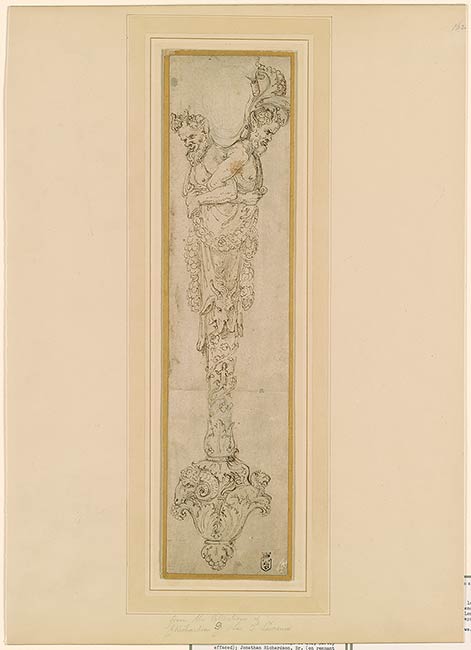
Giulio Romano’s work at the Gonzaga court in Mantua included not only architecture, painting, and architectural decoration but also designs for the decorative arts. Hundreds of drawings for metalwork survive by Giulio and his workshop.1 The present drawing is a particularly large and highly finished example, although the precise function of the object depicted remains an open question. Frederick Hartt identified it as the handle of a sword or mace, an ornamental staff that would be carried in procession before an official.2 The slender shaft with a pommel at the bottom does indeed suggest that the drawing was a design for some type of handle. In the catalogue of the Ellesmere sale in 1972, Julien Stock expanded on this description, identifying it as “the handle of a mace carried before a cardinal.” This seems to have confused the matter, for the secular imagery would not be appropriate for ecclesiastical ceremony.3 Moreover, the lizard that appears on the shaft of the object is one of the personal emblems of Federico Gonzaga and can also be found in the decorations of Palazzo Te and in other designs by Giulio.4 The lizard was believed not to be affected by love and was thus adopted by Federico as a foil for his own famous passions: in Federico’s imprese, the lizard is often accompanied by the motto QUOD HUIC DEEST, ME TORQUET, “what does not affect him the lizard, torments me Federico.” The drawing must thus date to sometime between Giulio’s arrival in Mantua in 1524 and Federico’s death in 1540, although it seems most likely to be from the earlier part of that period. There is no record, however, of any sort of ceremonial mace associated with Federico and the Gonzaga dukes. Elizabeth Eustis offered the alternate proposal that the drawing was for a mirror or a fan, ultimately preferring the latter in arguing that the salamander (an alternate identification of the lizard) and the winged lion at the base are symbols of heat or fire5 Nonetheless, it is unclear how the opening at the top of the design would relate to a sword, fan, mace, or mirror, so the ultimate identification of the object depicted here remains an open question.
Whatever the function of the object, the satyrs at the top of the handle also count among Federico Gonzaga’s personal symbols. Of course, satyrs are part of the classicizing language that runs throughout the design schemes for Palazzo Te (and much else in the Renaissance), but in the way that Federico amassed symbols, the imperial eagle of the Gonzaga arms came to be associated with Jupiter, and by extension Jupiter’s many guises came to be associated with Federico. Thus, as with Jupiter’s metamorphosis into a satyr as part of the Antiope myth, so too the satyr was a symbol for Federico. Indeed, the libidinous satyr was the perfect foil to the passionless lizard. Other metalwork designs by Giulio feature satyrs prominently, including one for an elaborate saltcellar with satyrs that was perhaps Giulio’s first design for silverware.6 Beyond any personal association with Federico, the satyrs were connected with wit and satire and as such relate more broadly to the sophisticated artifice of Giulio and the clever world of the court at Mantua.
—JJM
Footnotes:
- On Giulio’s designs for metalwork, see most recently Holman 2000 and New York 1999, both of which offer additional bibliography.
- Hartt 1958, 1: no. 119.
- Eustis in New York 1997, no. 23.
- See New York 1999, no. 18.
- New York 1997, no. 23.
- Holman 2000 discusses the saltcellar, known from Giulio’s drawing at the Monastery at Strahov, Prague.
Watermark: none visible through lining.
The lower segment of the stem was silhouetted for two inches by the artist and paste onto another sheet on which he continued the final section of the design.
Inscribed verso in pen and brown ink, "julio romano".
Richardson, Jonathan, 1665-1745, former owner.
Lawrence, Thomas, Sir, 1769-1830, former owner.
Ellesmere, Francis Egerton, Earl of, 1800-1857, former owner.
Sutherland, John Egerton, Duke of, 1915-2000, former owner.
Rhoda Eitel-Porter and and John Marciari, Italian Renaissance Drawings at the Morgan Library & Museum, New York, 2019, no. 41.
Selected references: Ellesmere 1898, no. 162; Hartt 1958, no. 119; Fellows Report 17 1976, 166; Los Angeles 1976, no. 105; Mantua 1989, 457; New York 1997, no. 23; New York 1999, no. 12.
Ryskamp, Charles, ed. Seventeenth Report to the Fellows of the Pierpont Morgan Library, 1972-1974. New York : Pierpont Morgan Library, 1976, p. 166.
